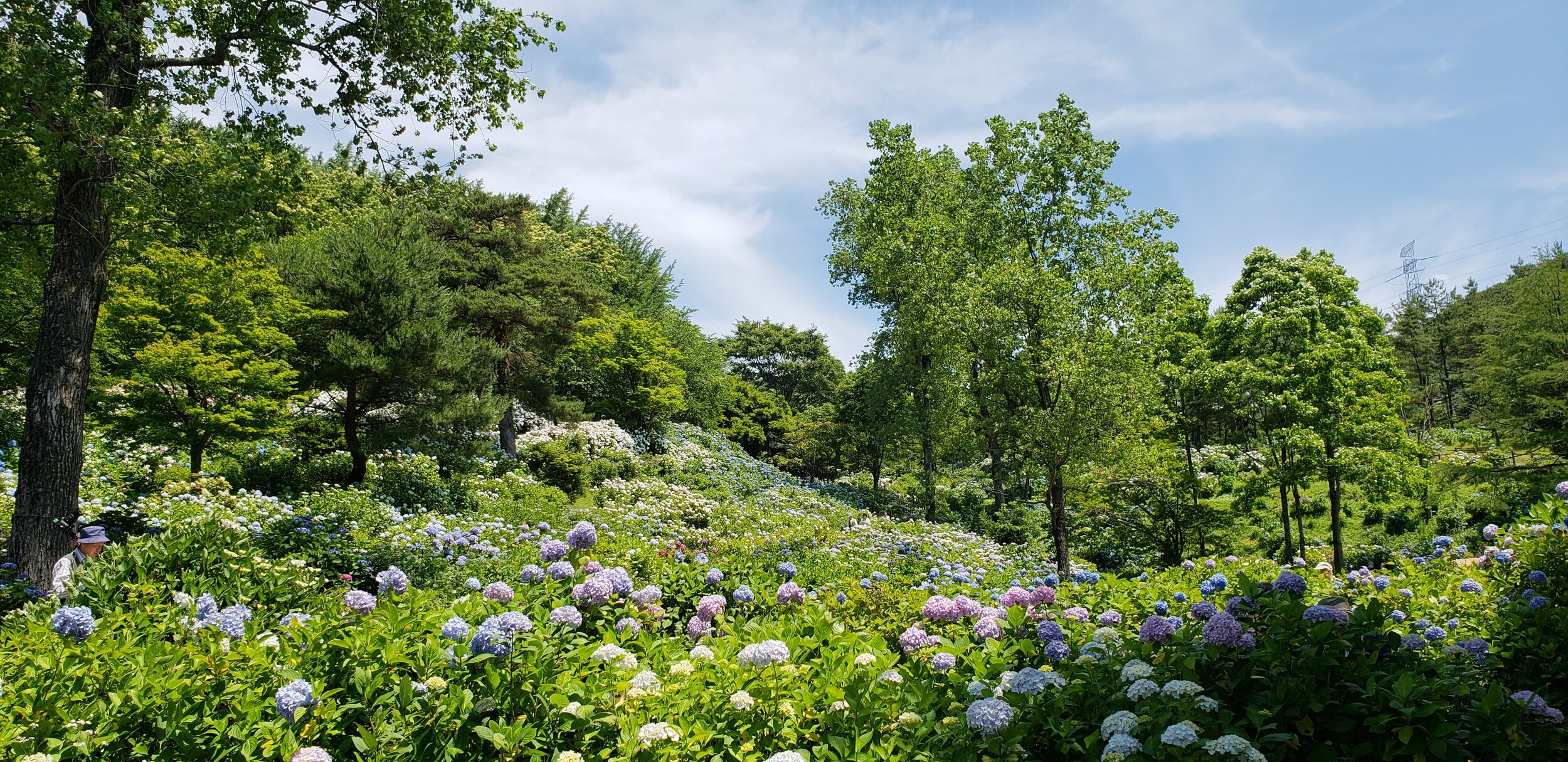Nature
THE BLOOMING SEAson
Spring: seas of hydrangea, wisteria waterfalls, and roses in bloom.
Maizuru Nature and Cultural Park
Have you ever seen friends and family members swallowed by waves of hydrangea bushes? 100,000 bushes, with flowers all in bloom and walking paths wending through them, will ensure some photographs and memories you won’t forget. The park sits on a hill with views of the sea down in the distance. In late spring the hydrangeas will start to bloom, but people come to the area way before that because the park also features a camellia forest. The 30,000-tree grove usually blooms in mid-march. There are many varieties to see as you lose yourself in the fragrance and colors of the camellia forest.
The Maizuru Nature and Cultural Park offers one more surprise for those who come in fall, because the surrounding mountains and large maple trees in the park change through a blaze of colors as fall progresses. There are excellent areas for picnics, where you will hear nothing but the sounds of nature.
hours:
March to September 9:00-17:00.
October to February 9:00-16:30
※last admission is 30 minutes before closing
closed: 12/29-1/3
There is a 500 yen adult/ 250 yen child entrance fee during the blooming season (there are group discounts)
camellia garden blooming season: March 19th - April 12
hydrangea garden blooming season: June 12 - July 12
admission during the fall foliage is free
Kannonji Temple (Hydrangea Temple)
Kannonji Temple is better known as the Hydrangea Temple because of the 10,000 hydrangeas in bloom in June. There are about 100 different varieties of hydrangea, with different colors and shapes. There are seasonal exhibitions during this time ranging from poetry to open-air tea ceremonies. On the 4th Sunday in June, there is an anual Hydrangea Festival as well. The temple has a 1300 year history and expansive grounds that include a variety of flowers, like wisteria and cherry blossoms. In fall, people also come to see the foliage here. The temple is only a 20 minute walk from Isa Station on the JR line. There is an entry fee that applies to the hydrangea blooming season only.
Taki Thousand Year Camellia Tree and Park
Taki “Thousand-year” Camellia
The Taki Camellia is an ancient Japanese camellia (yabu-tsubaki) tree located in a region formerly known as Taki. It is a precious relic of the camellia species found in the wild, preceding ornamental cultivars that are common today. Comparatively, the Taki Camellia blossoms are small, and they have a single layer of deep crimson petals surrounding a yellow center. The tree usually blooms between March and April, but the exact timing and volume of the bloom depend on climatic factors.
We will never know the exact age of the Taki Camellia, as the center of the tree and many of its growth rings have rotted away. Estimates based on the girth (3.26 meters) suggest it is between 500 and 1,200 years old. What is clear is that the tree has survived the centuries because of its location. Sturdy bedrock beneath the tree has protected it from landslides, and although the surrounding landscape is dotted with abandoned rice paddies, this particular spot was too steep for villagers to cultivate. Furthermore, the moist, partially shaded forest provides ideal growing conditions for camellias.
The tree was designated a Cultural Property of Kyoto Prefecture in 1989, and it now receives constant care. The land underneath has been fortified with stone terraces, and protective leather sheets are draped over split bark. Additionally, wooden supports hold the weight of heavy limbs.
Nearby there is a garden with dozens of camellia varieties, as well as the Kaya Camellia Culture Museum, which is recognizable by its camellia-blossom-shaped roof.
admission information:
The tree is always available for viewing, but the tree tends to be in bloom during December, and then again starting in mid-March.
Kaya Camellia Culture Museum: ¥200 adults, ¥100 for ES and JHS students.
museum hours: 9:00–5:00 p.m.
closed Mon. from March to May;
closed Mon., Tue., and Wed. from June to Nov. (Open if a national holiday and closed the following day instead.)
closed Dec. to Feb.
Learn about the Shaga Forest
oriental paper bush bloom begins in March
fringed wild irises often bloom at the end of April or early May
The Shaga Forest was discovered a few years ago by a local who happened upon a cedar forest carpeted in white by wild irises. This site has become one of the premire locations for viewing both wild irises and the oriental paperbush. It is certainly one of the natural wonders of Kyoto. In order to preserve this natural landscape as much as possible, small, non-invasive paths have been made so visitors can get lost in this flower forest. There is a donation box on the path before entering the forest where you can contribute to help preserve and maintain this rare natural phenomenon.
The oriental paperbushes, with their origami-like flowers are in bloom from late March until mid-April.
wild irises are in bloom from late April until mid-May.
Keep in mind that flowers don’t understand our months, and blooming periods are subject to the forces of nature.
Ayabe Gunze Rose Garden
Ayabe is a city synonymous with peace and world unity. In the downtown area, Omoto Headquarters is a vast complex that supports multi-denominational worship. And right down the street is the Ayabe Gunze Square Rose Garden. Wondering why the rose garden is a symbol of peace? It’s because the very center of the rose garden has a rare and precious variety, Anne’s Rose. These gorgeous flowers were gifted as seeds from Anne Frank’s father to select locations around the world. This is more than a symbolic gesture of “sowing peace” across the world, it is a physical reminder that we share this world and should aim to live in harmony with both each other and nature.
The garden has over 1,000 roses and 120 different varieties that are usually in bloom during June and October. With the fall foliage starting to peak as well, Ayabe is an incredible destination for all things nature.
hours: always open (the adjacent cafe and museums are subject to business hours.
admission: free
Love nature? We do to. There’s more internet nature to come when we get back inside.










